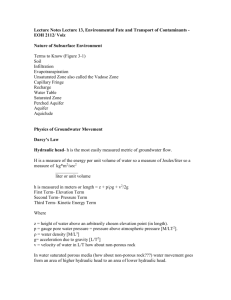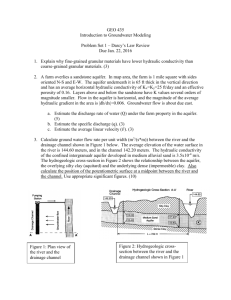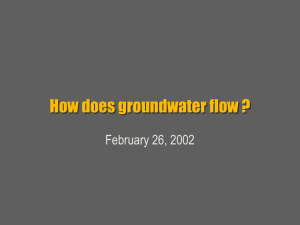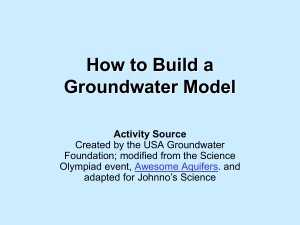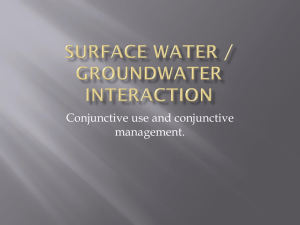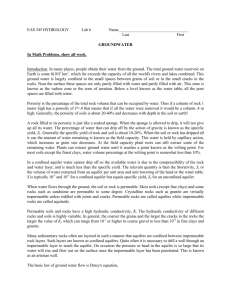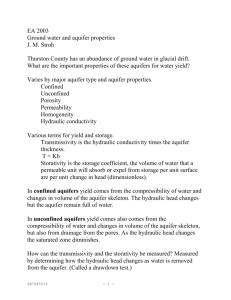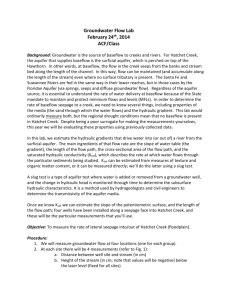Groundwater
advertisement
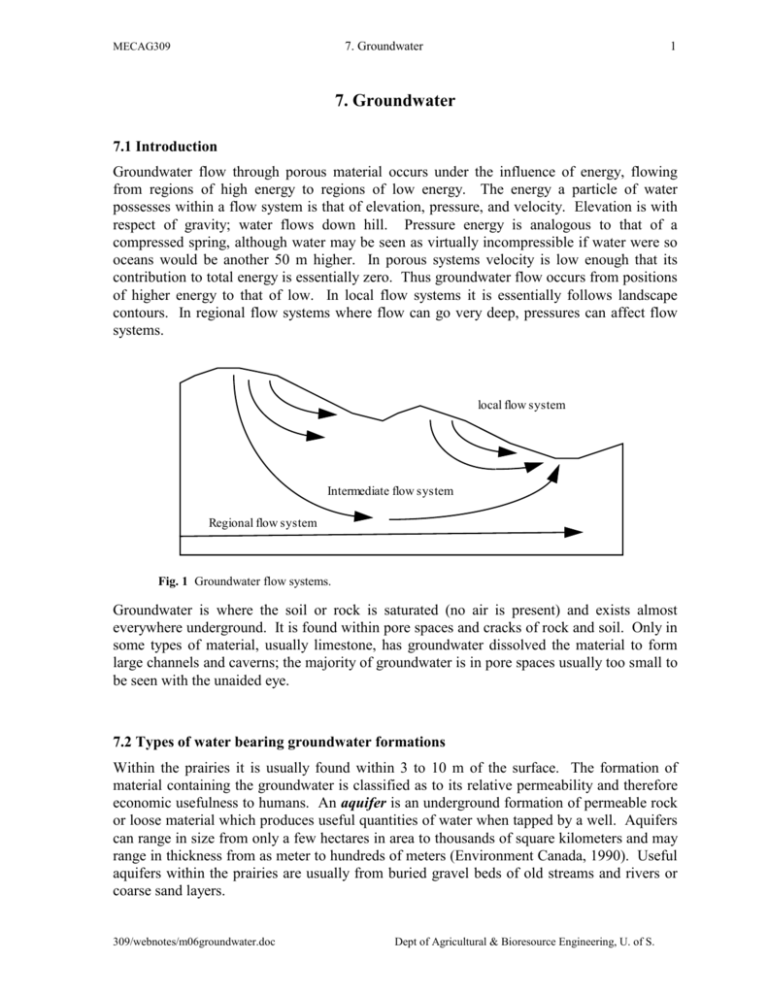
7. Groundwater MECAG309 1 7. Groundwater 7.1 Introduction Groundwater flow through porous material occurs under the influence of energy, flowing from regions of high energy to regions of low energy. The energy a particle of water possesses within a flow system is that of elevation, pressure, and velocity. Elevation is with respect of gravity; water flows down hill. Pressure energy is analogous to that of a compressed spring, although water may be seen as virtually incompressible if water were so oceans would be another 50 m higher. In porous systems velocity is low enough that its contribution to total energy is essentially zero. Thus groundwater flow occurs from positions of higher energy to that of low. In local flow systems it is essentially follows landscape contours. In regional flow systems where flow can go very deep, pressures can affect flow systems. local flow system Intermediate flow system Regional flow system Fig. 1 Groundwater flow systems. Groundwater is where the soil or rock is saturated (no air is present) and exists almost everywhere underground. It is found within pore spaces and cracks of rock and soil. Only in some types of material, usually limestone, has groundwater dissolved the material to form large channels and caverns; the majority of groundwater is in pore spaces usually too small to be seen with the unaided eye. 7.2 Types of water bearing groundwater formations Within the prairies it is usually found within 3 to 10 m of the surface. The formation of material containing the groundwater is classified as to its relative permeability and therefore economic usefulness to humans. An aquifer is an underground formation of permeable rock or loose material which produces useful quantities of water when tapped by a well. Aquifers can range in size from only a few hectares in area to thousands of square kilometers and may range in thickness from as meter to hundreds of meters (Environment Canada, 1990). Useful aquifers within the prairies are usually from buried gravel beds of old streams and rivers or coarse sand layers. 309/webnotes/m06groundwater.doc Dept of Agricultural & Bioresource Engineering, U. of S. 7. Groundwater MECAG309 2 Saturated zone Unsatur ated zone Water-table well Artesian well potentiometric surface capillary fringe Unconfined Aquifer water table Sand Aquitard (confining bed) Confined Aquifer Clay till Gravel layer Fig 2. Diagram showing hydrogeological conditions for an unconfined aquifer and a confined aquifer (adapted from Ward and Elliot, 1995) Aquitards are water bearing formations that are relatively impermeable. Due to small pore size or the crystalline nature of rock, water flows through very slowly. Formations of clay, silt or very compacted sand are aquitards. These layers do not supply water in quantities sufficent for our needs. Also aquitards form confining layers for aquifers, not allowing them upward movement. Aquifers can be that of unconfined if their upward surface is in contact with the unsaturated pore space of soils, thus they can directly receive drainage waters from infiltration and they can contribute through capillarity to the root zone or the evaporation front at the soil surface. In an unconfined aquifer the level of water in a well is referred to as the water table as it actually represents the saturated depth of water in the soil. Confined aquifers does not receive direct infiltration of precipitation because it is overlain by a layer of low permeability. As such it does not have a water table and the water is confined under a sufficient pressure that when a well is put into this layer the water level will rise above the base of the overlying confining layer. This type of well is referred to as a piezometer as it is cased along its entire length except for the bottom part which is screened so as to allow water in. The level of water within a piezometer is referred to as the piezometric surface and it represents the pressure of the water in the confined aquifer. A series of piezometers within the the same confined aquifer will provide an indication of flow direction. 309/webnotes/m06groundwater.doc Dept of Agricultural & Bioresource Engineering, U. of S. 7. Groundwater MECAG309 3 7.3 Flow rates and amounts How fast does groundwater flow? The rate at which water flows (q in volume of water per unit cross-sectional flow area per unit time, eg cm3 cm-2 d-1, m3 m-2 s-1) through the formation is dependent upon the hydraulic conductivity (K, cm/d) of the material and the pressure gradient (i, cm/cm is equivalent to slope as expressed in vertical rise over horizontal run). q=-Ki Hydraulic conductivity is the permeability of the material to fluid flow, and is an indicator of the potential for materials to transmit water. The smaller the pores and the more tortuos the pathway that water must travel between the pores the smaller the hydraulic conductivity; thus sands having large continuous pores have higher hydraulic conductivities than clays. Hydraulic gradient (i) is the force driving the water and is analogous to that of a hill slope, the steeper the slope the greater the force and thus the greater the flow rate, q. If the piezometric surface were measured in 2 parts of the landscape or at 2 depths within the same part of the landscape the gradient would then be the difference in piezometric surface expressed as the height of water (dh) divided by the distance between the piezometers (L); q = - K dh/L This relationship between flow rate, hydraulic conductivity, and gradient is known as Darcy's Law and is commonly used in groundwater studies to determine rates of well recharge, rates and amounts of contaminant movement, and economic worth of aquifer systems. Table 1. Hydraulic conductivity values for various types of earthen materials Material Shale Unweathered marine clay or unweathered glacial till Weathered glacial till Silt Silty sand; mixtures of sand-silt-clay Fine sand Clean sand Sand-gravel Clean gravel Relative permeability Hydraulic conductivity (cm/d) Hydraulic conductivity (gal/day/ft2) extremely low very low 0.0001 0.001 0.00002 0.0002 low low low 0.01 0.1 1 0.002 0.02 0.2 low moderate high very high 10 1000 10,000 100,000 2 20 2,000 20,000 Note the hydraulic conductivities presented above are the median value, within each material the hydraulic conductivity can easily range one or two orders of magnitude on either side of the above value. 1.0 cm/d = 0.25 gal/day/ft2 309/webnotes/m06groundwater.doc Dept of Agricultural & Bioresource Engineering, U. of S. 7. Groundwater MECAG309 4 So to answer the question, how fast does groundwater flow will depend upon the hydraulic conductivity and the gradient. As an example How fast does groundwater flow? Speedy system of a confined aquifer of a sand-gravel system with a hydraulic conductivity of 10,000 cm/d. Two piezometers installed in this aquifer 1 km apart have piezometric surfaces differing by 50 cm. The porosity of the material is 0.33 cm3/cm3. Flux = q (cm/s) = K dh/L = 10,000 x 50/100,000 = 5 cm/day Actual rate of water movment within the aquifer,v = q/n = 5 cm/d / 0.33 = 15.2 cm/d Distance a particle of water will travel in 1 year = 55 m Slow system of a aquitard of glacial till with a hydraulic conductivity of 0.01 cm/d. Two piezometers 1 km apart have piezometric surfaces differing by 50 cm. The porosity of the material is 0.33%. Flux = q (cm/s) = K dh/L = 0.01 x 50/100,000 = 5 x 10 -6 cm/d Actual rate of water movment within the aquifer, v = q/n = 15.2 x 10 -6 cm/d Time it will take for a water particle to travel 55 m = 55 m/v = about one million years. How much water can be pumped? Whether or not a formation can be used as a source of water for human usuage depends upon how much water can be supplied from its pore space and how fast that water can be pumped out. The specific storage (Ss) of a saturated aquifer is defined as the volume of water that a unit volume of aquifer releases from storage under a unit decline in hydraulic head. The transmissivity (T) of a confined aquifer of thickness b and hydraulic conductivity, K, is defined as T=Kb and the storativity (S) is defined as S = Ss b or as the volume of water that an aquifer releases from storage per unit area of auifer per unit decline in hydraulic head normal to that surface. Confined aquifers can be classified according to their ability to transmit groundwater in sufficient quantities to wells or springs. As water in confined aquifers is under pressure, it can yield water upon pumping without desaturation of the pore space, however large amounts of pumping over time can result in surface subsidence if the aquifer is close to the surface. Wells for rural household water can accept transmissivity values as low as 0.05 m2/d, however for large volume wells needed for irrigation purposes transmissivity valus should be greater than 1000 m2/day and ideally as large as 10,000 m2/day. 309/webnotes/m06groundwater.doc Dept of Agricultural & Bioresource Engineering, U. of S.
